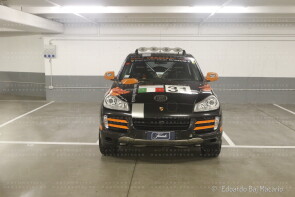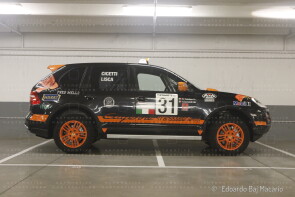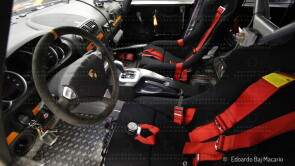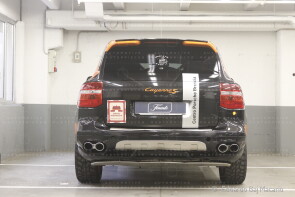
2007 Porsche Cayenne S Transsyberia
ON/OFF
Why am I an Automotive Masterpiece?
L. Limited edition cars
no. 26 manufactured
Although it wasn’t Porsche’s first “out-of-the-box” vehicle, breaking away from the brand's traditional standards, the Cayenne made waves upon its debut. The SUV, classified in the E-segment, was born in 2003 as part of a joint-venture project between Porsche and the Volkswagen Group, which also resulted in the Volkswagen Touareg and the Audi Q7. All three vehicles shared the same production plant in Bratislava, Slovakia. The mechanical layout and a considerable portion of the components were identical, though the engines differed. Porsche initially opted to use only its own petrol engine, a 4.5-liter V8, naturally aspirated for the Cayenne S and turbocharged for the Cayenne Turbo. Later, an entry-level version was introduced with a 3.2-liter V6 engine, derived from Volkswagen. At the other end of the spectrum, a Turbo S version was added, and a factory performance kit was available, pushing the power to an impressive 540 hp. Despite its distinctly sporty philosophy, typical of Porsche, the Cayenne was also well-suited for fairly demanding off-road use, limited only by its unibody construction. However, technical solutions, combined with permanent all-wheel drive, ensured excellent traction on all terrains with the appropriate tires. Continuously updated to meet the demands of a highly competitive market and sector, the Cayenne underwent a facelift in 2007, and in 2008, the Cayenne Diesel was introduced, marking the first Porsche ever equipped with a diesel engine. In 2010, the second-generation model was launched, featuring the first hybrid version, followed by the third generation in 2017.
The Porsche Cayenne Transsyberia derives from the street version of the SUV of the Stuttgart house, specifically set up for off-road racing. Only 26 units were made to participate in the Transsiberia Rally, an offroad race starting in Moscow and arriving in Ulaanbaatar in Mongolia, a route of over 6,600 kilometers. By regulation, the car had to be standard; therefore the Cayenne did not undergo any particular technical transformations. The engine remains the 4.8-liter, 385-hp 8-cylinder, the same as the road version, with a specific adaptation to the injection to be able to operate even with a low percentage of ethanol (up to a quarter). The tires were replaced with specific Michelin for the rough terrain, with a unique tread, able to guarantee traction on all surfaces. From the mechanical point of view, careful work was done on the transmission: self-locking differential and reduced gears on the axle transmission, while the gearbox remained the same as the standard version: the six-speed Tiptronic S with a different final ratio. The electronics include Porsche Active Suspension Management and Porsche Traction Management, in this case flanked by Porsche Dynamic Chassis Control, preset to a special offroad mode that allows the Cayenne to cross water obstacles of up to 76 cm. In the parts most exposed to contact with the ground, the car was equipped with a bumper sled on the underbody and steel flooring. To traverse deep waterways a snorkel was installed on the roof; along with a battery of additional lights, front winch, rear winch and a sports exhaust. The interior of the car is reduced to the essentials, to save weight and make room for the double spare wheels and two spare tanks that occupy the space of the rear seat, while the front seats have been replaced by two Recaro bucket seats, with four-point belts. Of the 26 Cayenne Transsyberia made, 16 took part in the 2007 edition; of these, two representing Italy: the official one of the Italian branch with the crew Antonio "Tonino" Tognana - Carlo Cassina and that of the Centro Porsche Brescia led by the duo Angelo Lancelotti and Biagio Capolupo. Italian cars were presented at the "Festival nazionale della letteratura e giornalismo di Viaggio" in May 2007 in Padua, two months before the start of the race.
The Porsche Cayenne S Transsyberia, chassis no. WP1ZZZ9PZ8LA32302, is one of the 16 Cayenne that took part in the 2007 edition of the Transsyberia Rally, and one of the two cars driven by Italian crews; specifically, is the car entered by Centro Porsche Brescia, driven by the experienced racing driver Angelo Lancelotti and the automotive expert Biagio Capolupo. The car ranked a 29th place overall; could have been better classified, but due to frequent punctures, the crew lost position. The car covered a total of 12,440 km and was never used after the race, chosen to be kept among the cars of the Saottini Collection. It has always been cared for by the Centro Porsche Brescia and is still fully set up and painted in the serigraphy with which ran the 2007 Transsyberia Rally. The car was put up for sale at the auction organized by Finarte in 2020, an event where Beatrice Saottini, a prominent figure in the Brescia automotive world, board member of the Mille Miglia, and heir to the prestigious V.A.G. dealership group, sold a significant number of pieces from the family collection. With a German delivery note for the car to Porsche Italy, Italian registration and plates in order, the car was sold and is now in a private collection.




